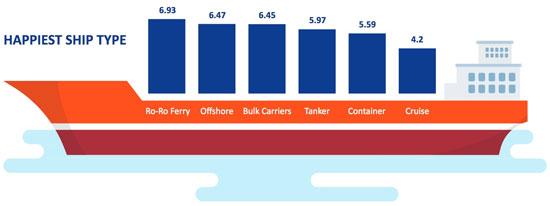A recent annual survey that gauges how happy people are in their working life at sea is getting mixed reviews within the industry.
The Seafarers Happiness Index, first conducted five years ago through Crewtoo before being taken over by The Mission to Seafarers international charity, found that overall seafarer satisfaction has decreased more than 5 percent in a year. The results, released last spring, also show rising concern about the mental well-being of seafarers, along with dissatisfaction over a lack of downtime, unreliable Wi-Fi, subpar food and inability to exercise sufficiently. Several women reported gender discrimination and sexual harassment at sea.
“The outcome doesn’t surprise us. The quality of life on board ship has decreased for years,” said Klaus Luhta, a vice president with the International Organization of Masters, Mates & Pilots (MM&P), a labor union representing licensed mariners and the marine division of the International Longshoremen’s Association. “The workload has increased steadily, particularly for captains and chief mates. They don’t sleep much. Not much attention is given to good food, so they don’t eat well.”
Luhta said operators often don’t adhere to international standards for rest, safety and quality of life. He said one obvious way to correct these problems is to increase the number of crewmembers on vessels, especially third mates, but that’s something “too few” companies are doing.
Not all agree, however. David Rider, president and executive director of the Seamen’s Church Institute (SCI), North America’s largest mariners’ service agency, took issue with The Mission to Seafarers’ “terrible scenario” results.
“I am deeply immersed in issues of mariners’ welfare and specialize in mental health, and I do not share their assessment,” Rider said, noting that members of his group “go face to face” with seafarers on 12 to 15 ships a day and don’t hear the type of feedback the Mission is reporting.
Rider acknowledged that the first voyages for younger mariners — away from the comforts of home and in the middle of the ocean — can be a tough adjustment, but that contrasts sharply with the experiences of seasoned, well-paid seafarers who accept and enjoy their lifestyle.
Rider questioned the survey’s methodology and pointed to the SCI’s instead.
 |
|
Mariners aboard roll-on/roll-off ferries reported a higher level of “general happiness” — 6.93 out of 10 — than crewmembers on other vessel types, according to the latest Seafarers Happiness Index. |
|
Courtesy The Mission to Seafarers |
“We do more scientific studies, in collaboration with Yale University, and just do not see that type of general decline in quality of life,” he said. “Yes, any ship has a different emotional temperature on any given day, but we come unannounced, and we can feel, see and smell — you get a feel for it — the mood, the quality of life.”
Index founder Steven Jones explained how the most recent survey results came together. More than 2,000 mariners contacted The Mission to Seafarers for this round, he said, representing “almost all ranks at sea, from deck crew to captain, oiler to chief,” and serving on a wide variety of vessels. Most respondents were serving on tankers, containerships or bulk carriers. Ages ranged from 16 to 65.
“Unfortunately, the gender split was low (reflecting the industry complexion), with only 5 percent of respondents being women,” Jones said.
The survey includes 10 questions, answered anonymously, covering key areas such as mental and physical health, diet, rest, workload, connectivity, training, access to shore leave, and relationships at home and on board. In the latest survey, the “general happiness” score declined to 6.31 on a 10-point scale from 6.69 in 2018.
Jones said the results are shared with the shipping industry. This “hopefully allows companies to take a pulse of life at sea, and to find how to make things better for seafarers,” he said. “The issues which crews raise are also the basis for some of the initiatives which are rolled out by the Mission.”
To get a full picture of the state of affairs at sea, Jones is always encouraging more mariners to take part in the survey.
“By sharing their feelings on a scale out of 10, and by providing some written insight, the index gives a voice to seafarers and addresses the fundamentals of why people are happy to go to sea — or not, as the case may be,” he said. “Every quarter, seafarers provide their input and insight, so we would encourage people at some point during each trip to sea to just take a few minutes to share their thoughts.”
The index can be completed at www.happyatsea.org.

